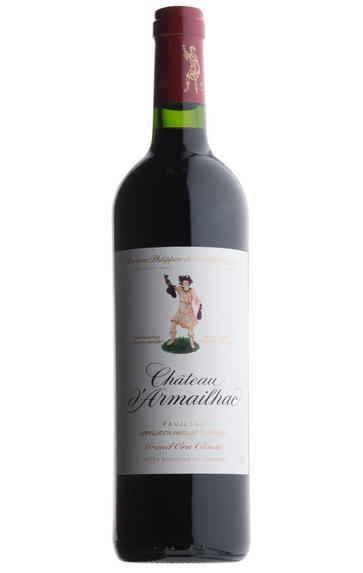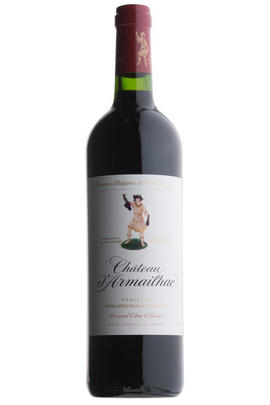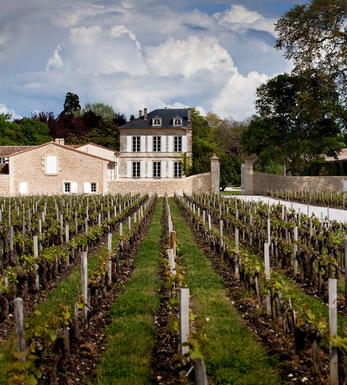
2022 Château d'Armailhac, Pauillac, Bordeaux

Critics reviews
The 2022 Armailhac is effusive and aromatic, with an extra kick of fruit intensity and richness from the warm, dry growing season, there’s no austerity at all in this young Armailhac. Hints of white pepper, blood orange and mint lend further brilliance. This is very nicely done. A sample presented at Mouton-Rothschild was five days old and oxidized.
Drink 2028 - 2042
Antonio Galloni, Vinous.com (April 2023)
The 2022 d'Armailhac is a blend of 60% Cabernet Sauvignon, 22% Merlot, 16% Cabernet Franc, and 2% Petit Verdot.
Deep garnet-purple in colour, it slowly emerges from the glass with evocative blueberry pie, black raspberries, and warm cassis scents, giving way to hints of pencil lead, lilacs, and underbrush. The full-bodied palate delivers taut, muscular black fruit with beautifully rounded tannins and plenty of freshness, finishing long and spicy. This year represents a real step up. pH 3.83, TPI 75.
Drink 2026 - 2042
Lisa Perrotti-Brown MW, The Wine Independent (May 2023)
Harvest September 8 to 27, 50% new oak, 3.83ph.
The difference from a typical vintage colour is more marked in Armailhac than Clerc Milon, where we are more used to deep colours. This in contrast, is a highly intense Armailhac, really stepping into its Pauillac boots, a ton of deep plum, cassis and damson. Great expansion through the palate and a beautiful depth of flavour; this is extremely impressive, with an edge of eucalyptus and graphite on the finish and more grip than usual. Yields down to 26hl/h (there are more new plantings here, so young vines). Second vintage with the new winery and new technical director Lucille Lauilhé.
Drink 2030 - 2046
Jane Anson, JaneAnson.com (May 2023)
60% Cabernet Sauvignon, 22% Merlot, 16% Cabernet Franc, 2% Petit Verdot. Cask sample.
Expressive Cabernet nose. Juicy fruit on the palate. A little more power than in some years, the tannins ripe but firm. Plenty of lift and length on the finish. Gourmand as well. 14.5%.
Drink 2030 - 2042
Jancis Robinson MW, JancisRobinson.com (May 2023)
Deep aromas of raspberries, cherries, crushed mint and spices preface the 2022 d'Armailhac, a medium to full-bodied, layered and concentrated wine that's deep, lively and seamless, framed by powdery tannins and conclude with a penetrating finish.
William Kelley, Wine Advocate (April 2023)
This is like a baby Mouton this year with blackcurrant, flower, and orange aromas. Medium- to full-bodied with a tight and racy palate that shows persistence and verve. One to watch.
James Suckling, JamesSuckling.com (April 2023)
3.83pH. 11.3% press wine - usually at 7-8% maximum. 2% Petit Verdot completes the blend. HVE3 certified. Tasted twice. 50% new barrels.
Strongly scented and perfumed on the nose, dark fruits are lively and lithe, supple and smooth on the palate, richly concentrated in terms of fruit density but sleek and stylish on the palate with a burst of bright and fresh blackcurrants and black cherries. It has a tang to it; the acidity and liveliness fill the mid-palate before the stony tannins come in towards the end and give this bite and focus. More tense and streamlined than Clerc Milon but so poised and finessed.
This has bite and tension; the Cabernet speaks with liquorice, tobacco and clove, subtly giving the spice at the end and a fresh mintiness. You can taste the gravel and the clay, putting the terroir in the glass. Quite profound, with concentrated fruit, juiciness and mouthwatering acidity. You want more of this fresh and lifted on the finish, but it will take some time to be more charming, given its serious nature. One to wait for and be glad you did.
Drink 2027 - 2049
Georgina Hindle, Decanter.com (April 2023)
Another wine that showed beautifully on multiple occasions, the 2022 Château D'Armailhac checks in as 60% Cabernet Sauvignon, 22% Merlot, 16% Cabernet Franc, and the rest Petit Verdot. This deep purple-hued beauty offers up a full-bodied, ripe, sexy profile that carries lots of blueberry, cherry, and cassis fruit, notes of spice, leafy herbs, and chocolate, velvety tannins, good acidity, and a great finish. It should have a broad, lengthy drink window.
Jeb Dunnuck, JebDunnuck.com (May 2023)
About this WINE

Château d'Armailhac
Classified as a Fifth Growth in 1855, Château d’Armailhac came under the ownership of the Baron Philippe de Rothschild family in 1933. Today Baroness Philippine’s children, Camille and Philippe Sereys de Rothschild and Julien de Beaumarchais de Rothschild continue the family’s quest for excellence and innovation in the vineyard and winery.
The 76-hectare estate is managed alongside stablemates Château Mouton Rothschild and Château Clerc Milon; expertise is shared across the properties.
The south-facing vineyard is located in the northern part of Pauillac, adjacent to Château Mouton Rothschild, and is made up of deep, gravelly soil favoured by Cabernet Sauvignon. It’s no surprise, then, that this grape dominates the planting with the rest given over to Merlot (35%), Cabernet Franc (8%) and Petit Verdot (2%). The Cabernet Franc vines, which have an average age of 60 years, derived from ancestral massal selection, make up a relatively high proportion of the blend and are a hallmark of the wine. Harvesting is done by hand, and the grapes are sorted and destemmed.

Pauillac
Pauillac is the aristocrat of the Médoc boasting boasting 75 percent of the region’s First Growths and with Grand Cru Classés representing 84 percent of Pauillac's production.
For a small town, surrounded by so many familiar and regal names, Pauillac imparts a slightly seedy impression. There are no grand hotels or restaurants – with the honourable exception of the establishments owned by Jean-Michel Cazes – rather a small port and yacht harbour, and a dominant petrochemical plant.
Yet outside the town, , there is arguably the greatest concentration of fabulous vineyards throughout all Bordeaux, including three of the five First Growths. Bordering St Estèphe to the north and St Julien to the south, Pauillac has fine, deep gravel soils with important iron and marl deposits, and a subtle, softly-rolling landscape, cut by a series of small streams running into the Gironde. The vineyards are located on two gravel-rich plateaux, one to the northwest of the town of Pauillac and the other to the south, with the vines reaching a greater depth than anywhere else in the Médoc.
Pauillac's first growths each have their own unique characteristics; Lafite Rothschild, tucked in the northern part of Pauillac on the St Estèphe border, produces Pauillac's most aromatically complex and subtly-flavoured wine. Mouton Rothschild's vineyards lie on a well-drained gravel ridge and - with its high percentage of Cabernet Sauvignon - can produce (in its best years) Pauillac's most decadently rich, fleshy and exotic wine.
Latour, arguably Bordeaux's most consistent First Growth, is located in southern Pauillac next to St Julien. Its soil is gravel-rich with superb drainage, and Latour's vines penetrate as far as five metres into the soil. It produces perhaps the most long-lived wines of the Médoc.
Recommended Châteaux
Ch. Lafite-Rothschild, Ch. Latour, Ch. Mouton-Rothschild, Ch. Pichon-Longueville Baron, Ch. Pichon Longueville Comtesse de Lalande, Ch. Lynch-Bages, Ch. Grand-Puy-Lacoste, Ch, Pontet-Canet, Les Forts de Latour, Ch. Haut-Batailley, Ch. Batailley, Ch. Haut-Bages Libéral.

Cabernet Sauvignon Blend
Cabernet Sauvignon lends itself particularly well in blends with Merlot. This is actually the archetypal Bordeaux blend, though in different proportions in the sub-regions and sometimes topped up with Cabernet Franc, Malbec, and Petit Verdot.
In the Médoc and Graves the percentage of Cabernet Sauvignon in the blend can range from 95% (Mouton-Rothschild) to as low as 40%. It is particularly suited to the dry, warm, free- draining, gravel-rich soils and is responsible for the redolent cassis characteristics as well as the depth of colour, tannic structure and pronounced acidity of Médoc wines. However 100% Cabernet Sauvignon wines can be slightly hollow-tasting in the middle palate and Merlot with its generous, fleshy fruit flavours acts as a perfect foil by filling in this cavity.
In St-Emilion and Pomerol, the blends are Merlot dominated as Cabernet Sauvignon can struggle to ripen there - when it is included, it adds structure and body to the wine. Sassicaia is the most famous Bordeaux blend in Italy and has spawned many imitations, whereby the blend is now firmly established in the New World and particularly in California and Australia.


Buying options
Add to wishlist
Description
Cabernet Sauvignon 60%; Merlot 22%; Cabernet Franc 16%; Petit Verdot 2%
This is a sibling and neighbour of Ch. Mouton Rothschild. Usually, the vineyard’s sand and gravel soils give the wine a refined, slightly austere, but not powerful structure. This year, the intensity of the raw material means the wine feels more amplified. The tannins are complete, with more texture around their normal sinewy muscle. The fruit is zippy, bright, floral, tight and spicy – very Pauillac. The blend has a good amount of old-vine Cabernet Franc, undoubtedly adding its subtle hedgerow and dog rose notes to the wine.
Drink 2029 - 2050
Score: 17.5/20
Berry Bros. & Rudd
wine at a glance
Delivery and quality guarantee